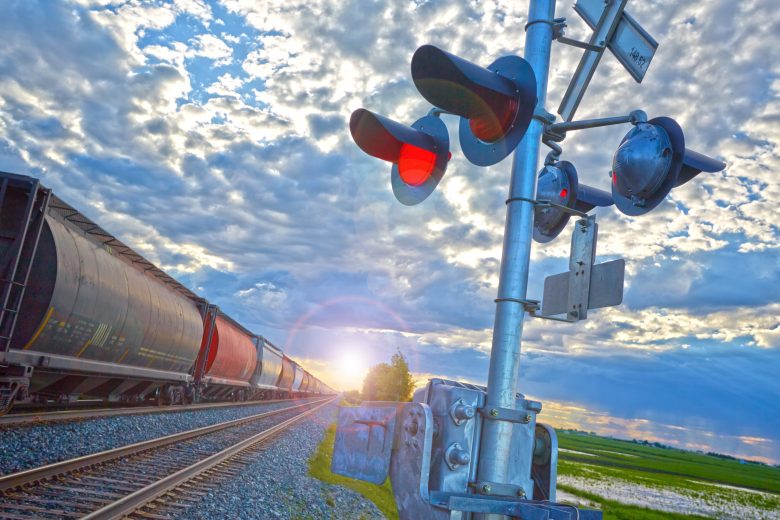Train safety can go off the rails in any number of ways. However, through improved awareness, workers and employers alike can make working on the railway better for everyone by taking into account safety issues that plague the industry—including human factors that affect employees’ well-being.
Tank cars not strong enough to transport dangerous goods
Railcars are a common way to transport fuel to areas where pipelines are not set up. Crude oil was first transported in large quantities by rail in 2012. Prior to then, trains were shorter, and spills were smaller and less likely to occur. Since 2012, there have been at least twelve significant accidents involving trains carrying crude oil in North America, the worst being a derailment in Lac-Mégantic, Quebec in 2013, when an unattended, runaway 74-car freight train carrying crude oil exploded, leveling the downtown, destroying at least 30 buildings and killing 47 people (42 confirmed, 5 presumed).
That accident sparked immediate action for stricter safety measures, especially for the containers that transport the material. In 2015, the thin-shelled DOT-111 containers that were used in the Lac-Mégantic incident (meant for liquids but not necessarily hazardous materials) were mandated to be replaced by the newly designed, safer DOT-117 cars.
Although change is imminent, it will take time. Railcar fleets are not expected to fully meet the new standards until 2029. Prior to the DOT-117 replacement, the CPC-1232 was designed to replace the DOT-111s but were found to only be a slight improvement and are just as unsafe in derailments. It is expected that the riskiest, non-jacketed DOT-111 will carry ethanol until May 2023 and the CRC-1232 will go beyond that with an expected removal date set for 2025.
Until this change is fully implemented, it’s more important than ever to be diligent and follow proper protocol, like removing aging railcars from service, supplying the appropriate number of crew for the operation of those trains and conducting regular track inspections to alleviate the risk of impact or combustion.
Lack of communication
Communication is one of the keys to maintaining a safe environment in any industry. While direct communication between workers is important, especially when it comes to conversations over a radio, it is not the only communication that’s sometimes lacking on the rail lines.
Employers must also keep workers informed of key safety issues, including notification about safety occurrences or audits, near misses, the outcome of inspections and operating/environmental conditions.
Implementing an effective safety management system also requires good communication. Safety management systems should include a process to identify requirements for complying with safety legislation, minimize risk and enhance the safety culture. It’s paramount that a good SMS is in place and regularly communicated.
Inadequate safety training
Up-to-date training is vital, given the strict requirements for transporting dangerous goods by rail, compliance audits, and continual updates to rail safety standards. New or contract employees are arguably the ones who require this training most, but employers should take steps to ensure that every worker has received current training and has the opportunity to ask questions and receive clarification on tasks.
When a railway regularly carries large quantities of products like crude oil, it should conduct a risk assessment and have a plan in place for deploying response resources necessary to contain and clean up any spill no matter where it occurs along the course of delivery. All employees must be trained on these spill response plans and they need to be communicated to all parties that may be involved in the response.
Implementing regular compliance audits is another great way to educate employees on better safety practices. Being proactive in identifying at-risk employees or situations and communicating any previous failures that have occurred will help to reduce future incidents.
Failing to address human factors
Many people underestimate the power human factors have on health and safety compliance. Even when people know the rules and procedures, their actions can be unintentionally compromised by their state of mind. For example, if a worker is fatigued after a long work week, he may not be as alert to train movement. Workers that have become complacent on the job may not take enough heed when working close to a railcar; ideally, they should keep at least 50 feet from the ends of stationary cars but workers with a skewed sense of risk may not follow these recommendations. If a worker is rushed, they may forget to look both ways when crossing a track or if they are frustrated, they may neglect mandatory PPE because their headspace is affected by their emotions.
Sometimes a job will have unavoidable hazards and risks. Training employees on how to account for human factors can mitigate these risks by making workers more attuned to their environment, more aware of work occurring around them, and more likely to look out for themselves and others. And in the end, that will lead to a safer railway industry for everyone.

